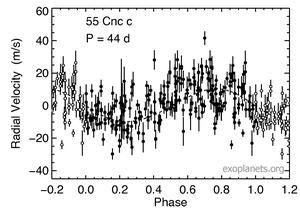55 Cancri c
| Exoplanet | List of exoplanets | |
|---|---|---|
 |
||
| Parent star | ||
| Star | 55 Cancri A | |
| Constellation | Cancer | |
| Right ascension | (α) | 08h 52m 35.8s |
| Declination | (δ) | +28° 19′ 51″ |
| Apparent magnitude | (mV) | 5.95 |
| Distance | 40.3 ± 0.4 ly (12.3 ± 0.1 pc) |
|
| Spectral type | G8V | |
| Mass | (m) | 0.95 ± 0.10 M☉ |
| Radius | (r) | 1.152 ± 0.035 R☉ |
| Temperature | (T) | 5373 ± 9.7 K |
| Metallicity | [Fe/H] | 0.29 |
| Age | 7.4–8.7 Gyr | |
| Orbital elements | ||
| Semi-major axis | (a) | 0.240 ± 0.00005AU (37.4 Gm) |
| 19.2 mas | ||
| Periastron | (q) | 0.219 AU (32.8 Gm) |
| Apastron | (Q) | 0.260 AU (39.0 Gm) |
| Eccentricity | (e) | 0.086 ± 0.052 |
| Orbital period | (P) | 44.3446 ± 0.007d (0.121407 y) |
| Argument of periastron |
(ω) | 77.9 ± 29° |
| Time of periastron | (T0) | 2,449,989.3385 ± 3.3JD |
| Semi-amplitude | (K) | 10.18 ± 0.43m/s |
| Physical characteristics | ||
| Minimum mass | (m sin i) | 0.169 ± 0.008MJ |
| Stellar flux | (F⊙) | 11 ⊕ |
| Discovery information | ||
| Discovery date | June 13, 2002 | |
| Discoverer(s) | Marcy et al. | |
| Discovery method | Radial velocity | |
| Discovery site | California, USA | |
| Discovery status | Published | |
| Other designations | ||
|
Brahe, 55 Cancri Ac, Rho1 Cancri c, HD 75732 c
|
||
| Database references | ||
| Extrasolar Planets Encyclopaedia |
data | |
| SIMBAD | data | |
| Exoplanet Archive | data | |
| Open Exoplanet Catalogue | data | |
55 Cancri c (abbreviated 55 Cnc c), also named Brahe, is an extrasolar planet in an eccentric orbit around the Sun-like star 55 Cancri A, making one revolution every 44.34 days. It is the third known planet in order of distance from its star. 55 Cancri c was discovered on June 13, 2002 and has a mass roughly half of Saturn.
In July 2014 the International Astronomical Union launched a process for giving proper names to certain exoplanets and their host stars. The process involved public nomination and voting for the new names. In December 2015, the IAU announced the winning name was Brahe for this planet. The winning name was submitted by the Royal Netherlands Association for Meteorology and Astronomy of the Netherlands. It honors the astronomer Tycho Brahe.
Like the majority of known extrasolar planets, 55 Cancri c was detected by observing changes in its star's radial velocity. This was achieved by making sensitive measurements of the Doppler shift of the star's spectrum. At the time of discovery, 55 Cancri A was already known to possess one planet (55 Cancri b); however, there was still a drift in the radial velocity measurements which was unaccounted for.
In 2002, further measurements revealed the presence of a long-period planet in an orbit at around 5 AU from the star. Even when both of the two planets were accounted for, there was still a periodicity at around 43 days. However, this period is close to the rotation period of 55 Cancri A, which led to the possibility that the 43-day period was caused by stellar rotation rather than a planet. Both the 43-day planet (designated 55 Cancri c) and the 5 AU planet (designated 55 Cancri d) were announced in the same paper, labeled in order of increasing distance from the star.
...
Wikipedia
